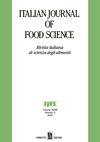部分用荸荠粉替代小麦粉的拉面的技术、质量和营养特性
IF 3.3
4区 农林科学
Q2 FOOD SCIENCE & TECHNOLOGY
引用次数: 0
摘要
通过在传统小麦粉中添加 30%、40% 和 50%(重量百分比)的马蹄粉,制备了拉面。研究了混合面粉的成分、糊化和拉面指数。对面条的色泽、自由基清除和功能特性进行了分析。替换后,面团发育时间、稳定性和远红外质量数分别从 5.250±0.07 分钟、6.45±0.07 分钟和 81.50±0.71 分钟显著下降至 1.20±0.01 分钟、1.31±0.01 分钟和 18.50±0.71。据统计,糊化温度(60.91±0.01 至 72.05±0.07°C)、峰值粘度(1094.05±0.07 至 1099.25±0.35 Brabender Unit,BU)、分解(310.05±0.07 至 376.05±0.07 BU)、热糊(782.05±0.07 至 996.10±0.14 BU)和冷糊粘度(1548.10±0.14 至 1701.25±0.35 BU)。非传统拉面的纤维、抗氧化潜力和矿物质含量明显提高,脂肪和热量的百分比显著降低。拉面的颜色变化数据如下L*(66.35-57.86);a*(0.24-2.08);b*(4.03-4.47)。随着栗子粉含量的增加,质地享乐得分在 8.38 和 7.57 之间变化。拉面样品的硬度介于 13.9 和 19.8 N 之间。本文章由计算机程序翻译,如有差异,请以英文原文为准。
Technological, quality and nutritional characteristics of Ramen noodles with wheat flour partially substituted by water chestnut flour
Ramen noodles were prepared by partially supplementing traditional wheat flour with water chestnut flour (WCF) at 30, 40 and 50% levels w/w. The composition, pasting and farinograph indices of flour blends were studied. Noodles were analysed for colour, radical scavenging and functional characteristics. Time for dough development, stability and farinograph quality number declined significantly from 5.250±0.07 to 1.20±0.01 min, 6.45±0.07 to 1.31±0.01 min and 81.50±0.71 to 18.50±0.71, respectively, after replacement. Statistically significant increment in pasting temperature (60.91±0.01 to 72.05±0.07°C), peak viscosity (1094.05±0.07 to 1099.25±0.35 Brabender Unit, BU), breakdown (310.05±0.07 to 376.05±0.07 BU), hot paste (782.05±0.07 to 996.10±0.14 BU) and cold paste viscosities (1548.10±0.14 to 1701.25±0.35 BU) were found with the addition of WCF. Non-traditional ramen exhibited significantly improved fibre, antioxidant potential and mineral content with significant reduction in % fat and caloric count. The colour variation data in ramen noodles were: L* (66.35–57.86); a* (0.24–2.08); and b* (4.03–4.47). Texture hedonic scores varied between 8.38 and 7.57 with chestnut flour level increment. Hardness of Ramen noodles samples ranged between 13.9 and 19.8 N.
求助全文
通过发布文献求助,成功后即可免费获取论文全文。
去求助
来源期刊

Italian Journal of Food Science
工程技术-食品科技
CiteScore
4.20
自引率
0.00%
发文量
33
审稿时长
>36 weeks
期刊介绍:
"Italian Journal of Food Science" is an international journal publishing original, basic and applied papers, reviews, short communications, surveys and opinions on food science and technology with specific reference to the Mediterranean Region. Its expanded scope includes food production, food engineering, food management, food quality, shelf-life, consumer acceptance of foodstuffs, food safety and nutrition, energy and environmental aspects of food processing on the whole life cycle.
Reviews and surveys on specific topics relevant to the advance of the Mediterranean food industry are particularly welcome.
 求助内容:
求助内容: 应助结果提醒方式:
应助结果提醒方式:


